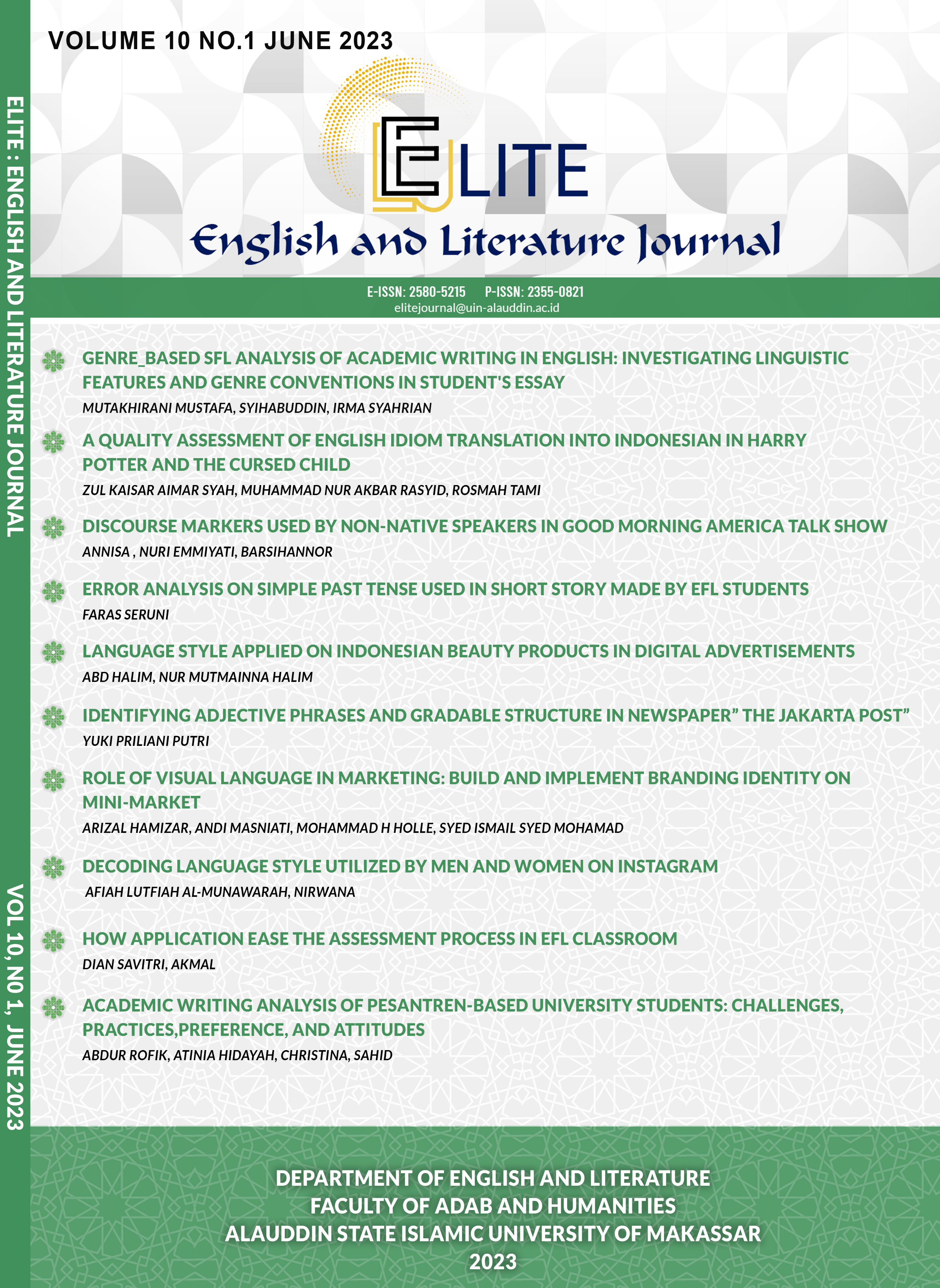A Quality Assessment of English Idiom Translation into Indonesian in Harry Potter and The Cursed Child
Abstract
This study aims to determine the quality of idiom translation and identify strategies applied by the translator in translating English idiomatic expressions into Indonesian in Harry Potter and the Cursed Child by Jack Thorne, J.K. Rowling, and John Tiffany. In achieving these goals, this research uses mixed-method approaches. It is analyzed based on the Translation Quality Assessment (TQA) model by Nababan et al. (2012) and Baker’s theory about strategies for translating idioms (2018). Meanwhile, the data was collected through questionnaires distributed to the informants. The research finding showed that the translator applies five idiom translation strategies in 70 data. Based on the frequency, the idiom translation strategies are translation by paraphrase (58.6%), literal translation (27.1%), using the idiom with similar meaning but the dissimilar form (8.6%), using an idiom with similar meaning and form (4.3%), and translation by the omission of play of idiom (1.4%). Meanwhile, the average score for the accuracy of the translation is 2.8. The average score for the acceptability of the translation is 2,8, and the average score for readability is 2.8. Overall, the average score of the English idiom translation quality in Harry Potter and the Cursed Child books is 2,8, which indicates that the translation has good quality, in other words, most of the translation is accurate, acceptable, and easily understood by the target readers
Downloads
References
Ammer, C. (2013). The American Heritage Dictionary of Idioms. In Angewandte Chemie International Edition, 6(11), 951–952. (Second). Houghton Mifflin Harcourt.
Arono, & Nadrah. (2019). Students’ Difficulties in Translating English Text. JOALL (Journal of Applied Linguistics & Literature), 4(1), 88–99. https://ejournal.unib.ac.id/joall/article/view/7384/3654
Ayuningtyas, D. P., Ifadah, M., & Aimah, S. (2018). Students ’ Difficulties in Translating Idiomatic Expression from English into Indonesian. 2nd English Language and Literature International Conference (ELLiC) Proceedings, 2, 494–501.
Baker, M. (2018). In Other Words: A Coursebook on Translatoin (Third Edit). Routledge.
Barnwell, K. (1980). Introduction to Semantics and Translation. Summer Institute of Linguistics.
Bassnett, S. (2002). Translation Studies (Third Edit). Routledge.
Catford, J. C. (1965). A Linguistic Theory of Translation: An Esay in Applied Linguistics. Oxford Univeristy Press.
Chen, L. (2009). On Literal Translation of English Idioms. English Language Teaching, 2(2), 164–166.
Farlex. (2017). Farlex Idioms & Slang Dictionary. In Farlex International. Farlex International.
Haris, F., & Bismoko, J. (2014). The Functions of Idioms with Magical Terminology in Building the Story of J.K. Rowling’s “Harry Potter and the Order of the Phoenix.” Jurnal LingTera, 1, 185–195.
Huda, M. (2019). Animal idioms in english. English and Literature Journal, 6(2), 199–209. https://journal.uin-alauddin.ac.id/index.php/elite/article/view/11242/7488
Larson, M. L. (1984). Meaning-Based Translation: A Guide to Cross-Language Equivalence (Second Edi). University Press of America.
Nababan, M., Nuraeni, A., & Sumardiono. (2012). Pengembangan Model Penilaian Kualitas Terjemahan. Kajian Linguistik Dan Sastra, 24(1), 39–57.
Newmark, P. (1988). A Textbook of Translation. Prentice Hall International.
Nida, E. A., & Taber, C. R. (1982). The Theory and Practice of Translation. In Theory and practice in translation: Vol. VIII. E.J. Brill.
Oxford. (2004). Oxford Dictionary of Idioms (J. Siefring (ed.); Second). Oxford Univeristy Press.
Saputro, R. F. (2012). Idioms and Strategies of Translation in Harry Potter and the Deathly Hallows. Anglicist, 01(02), 23–28.
Schaffner, C. (1997). From “Good” to “Functionally Appropriate”: Assessing Translation Quality. Current Issues In Language and Society, 4(1), 1.
Shojaei, A. (2012). Translation of Idioms and Fixed Expressions: Strategies and Difficulties. Theory and Practice in Language Studies, 2(6), 1220–1229.
Thorne, J., Rowling, J. K., & Tiffany, J. (2016). Harry Potter and The Cursed Child. Arthur A. Levine Books.
Willams, M. (2004). Translation Quality Assessment: An Argumentation-Centred Approach (Vol. 15, Issue 2). University of Ottawa Press.
Copyright (c) 2023 Zul Kaisar Aimar Syah, Muhammad Nur Akbar Rasyid, Rosmah Tami

This work is licensed under a Creative Commons Attribution-NonCommercial-ShareAlike 4.0 International License.
Once an article was published in the journal, the author(s) are:
granted to the journal right licensed under Creative Commons License Attribution that allows others to share the work with an acknowledgement of the work's authorship.
permitted to publish their work online in third parties as it can lead wider dissemination of the work.
continue to be the copyright owner and allow the journal to publish the article with the CC BY-NC-SA 4.0 license
receiving a DOI (Digital Object Identifier) of the work.


